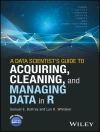The concept of ‘shape’ is at the heart of image processing and computer vision, yet researchers still have some way to go to replicate the human brain’s ability to extrapolate meaning from the most basic of outlines. This volume reflects the advances of the last decade, which have also opened up tough new challenges in image processing. Today’s applications require flexible models as well as efficient, mathematically justified algorithms that allow data processing within an acceptable timeframe.
Examining important topics in continuous-scale and discrete modeling, as well as in modern algorithms, the book is the product of a key seminar focused on innovations in the field. It is a thorough introduction to the latest technology, especially given the tutorial style of a number of chapters. It also succeeds in identifying promising avenues for future research. The topics covered include mathematical morphology, skeletonization, statistical shape modeling, continuous-scale shape models such as partial differential equations and the theory of discrete shape descriptors. Some authors highlight new areas of enquiry such as partite skeletons, multi-component shapes, deformable shape models, and the use of distance fields.
Combining the latest theoretical analysis with cutting-edge applications, this book will attract both academics and engineers.
表中的内容
Part I Discrete Shape Analysis: 1 Modeling Three-Dimensional Morse and Morse-Smale Complexes by L. Čomić et al.- 2 Geodesic Regression and its Application to Shape Analysis by P.Th.Fletcher.- 3 Segmentation and Skeletonization on Arbitrary Graphs Using Multiscale Morphology and Active Contours by P.Maragos and K.Drakopoulos.- 4 Refined Homotopic Thinning Algorithms and Quality Measures for Skeletonisation Methods by P.Peter and M.Breuß.- 5 Nested Sphere Statistics of Skeletal Models by S.M.Pizer et al.- 6 3D Curve Skeleton Computation and Use for Discrete Shape Analysis by G.Sanniti di Baja and C.Arcelli.- 7 Orientation and Anisotropy of Multi-component Shapes by J. Žunić and P.L.Rosin.- Part II Partial Differential Equations for Shape Analysis: 8 Stable semi-local features for non-rigid shapes by R.Litman et al.- 9 A brief survey on semi-Lagrangian schemes for image processing by E.Carlini et al.- 10 Shape reconstruction of symmetric surfaces using Photometric Stereo by R.Mecca and S.Tozza.- 11 Remeshing by Curvature Driven Diffusion by S.Morigi and M.Rucci.- 12 Group-valued Regularization for Motion Segmentation of Articulated Shapes by G.Rosman et al.- 13 Point Cloud Segmentation and Denoising via Constrained Nonlinear Least Squares Normal Estimates by E.Castillo et al.- 14 Distance Images and the Enclosure Field: Applications in Intermediate-Level Computer and Biological Vision by S.W.Zucker.- Part III Optimization Methods for Shape Analysis: 15 Non-rigid Shape Correspondence Using Pointwise Surface Descriptors and Metric Structures by A.Dubrovina et al.- 16 A Review of Geometry Recovery from a Single Image Focusing on Curved Object Reconstruction by M.R.Oswald et al.- 17 On Globally Optimal Local Modeling: From Moving Least Squares to Over-Parametrization by S. Shem-Tov et al.- 18 Incremental Level Set Tracking by S.Dekel et al.- 19 Simultaneous Convex Optimization of Regions and Region Parameters in Image Segmentation Models by E.Bae et al.- 20 Fluctuating Distance Fields, Parts, Three-Partite Skeletons by S.Tari.- 21 Integrated DEM Construction and Calibration of Hyperspectral Imagery: A Remote Sensing Perspective by Ch.Wöhler and A.Grumpe.- Index.












